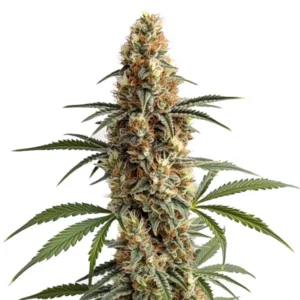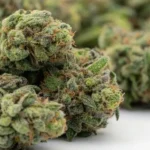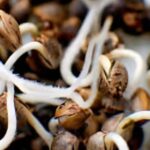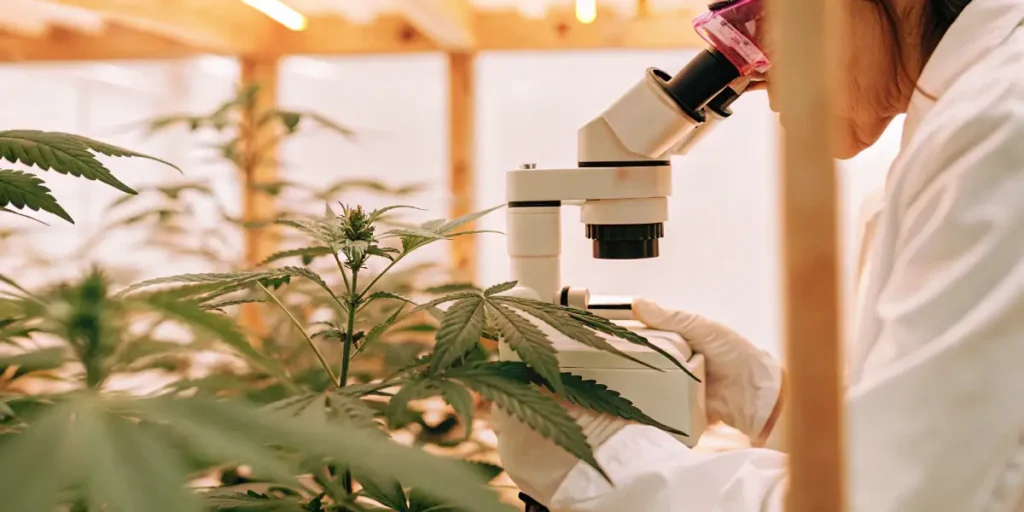
Importance of Laticifers in Cannabis
The importance of laticifers in cannabis cannot be overstated. These microscopic, tube-like structures are found in many plants, including the cannabis plant. They play a pivotal role in the plant’s physiology, contributing to various essential functions. Laticifers are responsible for the production and storage of latex, a sticky substance that is crucial for the plant’s survival and health.
Laticifers have a direct impact on cannabis resin production, which is what many cannabis enthusiasts are after. The resin contains the cannabinoids and terpenes responsible for the plant’s psychoactive and therapeutic effects. By knowing how laticifers work, both novice and seasoned growers can enhance resin production and improve the quality of their cannabis crops.
Recommended Strains
Sour Diesel
|
|
THC | 22% - 25% (Medium) |
|
|
Type | Feminized |
|
|
Yield | High |
|
|
Phenotype | 30% Indica / 70% Sativa |
Grape Ape
|
|
THC | 15% - 25% (Medium) |
|
|
Type | Feminized |
|
|
Yield | High |
|
|
Phenotype | 90% Indica / 10% Sativa |
Moreover, the function of laticifers in cannabis plant health should not be ignored. They act as a defense mechanism, protecting the plant from pests and diseases. This natural protection is vital for maintaining a healthy cannabis garden, reducing the need for chemical interventions, and ultimately leading to more sustainable cultivation practices.
Function of Laticifers in Cannabis Plant Health
Laticifers serve as a crucial defense line for the cannabis plant. These structures secrete latex, which can deter herbivores and prevent infections. When a plant is damaged, the latex quickly seals the wound, minimizing the risk of pathogen entry. This self-healing property is essential for the plant’s survival in the wild and in cultivation.
In a cultivation setting, the function of laticifers in cannabis plant health becomes even more significant. Growers often face challenges such as pests and diseases that can devastate a crop. By fostering strong laticifer development, cultivators can enhance their plants’ natural resilience. This reduces the reliance on chemical pesticides, leading to healthier plants and a cleaner end product.
The importance of laticifers in cannabis is further highlighted by their ability to influence plant vigor. Healthy laticifers ensure efficient nutrient transport and storage, which boosts the overall vitality of the plant. This results in more robust growth and greater resistance to environmental stressors, ultimately improving the yield and quality of the cannabis produced.
Additionally, laticifers play a key role in the plant’s ability to adapt to different growing conditions. Whether it’s changes in temperature or humidity, laticifers help maintain a stable internal environment, ensuring that the plant continues to function optimally. This adaptability is crucial for growers who need to manage varying environmental factors to achieve optimal cultivation results.
Impact of Laticifers on Cannabis Resin Production
Resin production is a key concern for cannabis growers, as it directly affects the potency and flavor profile of the plant. Laticifers contribute to resin production by transporting and storing the compounds that make up the resin. These include cannabinoids like THC and CBD, as well as aromatic terpenes.
By optimizing laticifer function, growers can potentially increase resin yield. This means more potent buds and a more aromatic product. Strains like Sour Diesel from Blimburn Seeds are known for their high resin content, partly due to robust laticifer activity.
The impact of laticifers on cannabis resin production is profound, as these structures are directly involved in the synthesis and accumulation of essential compounds. The efficiency of laticifers can determine the quality and quantity of the resin, making them a focal point for any serious cannabis cultivator. By leveraging their function, growers can produce resin that meets both commercial and personal standards.
Furthermore, knowing laticifer function in cannabis cultivation allows for targeted interventions that can enhance resin production. Techniques such as selective pruning and controlled stress application can stimulate laticifer activity, leading to an increase in resin output. This underscores the importance of laticifers in cannabis as a central component of high-quality cultivation practices.
Significance of Laticifers in Cannabis Defense Mechanisms
Defense mechanisms in cannabis are critical for the plant’s survival. Laticifers play a significant role in this defense by producing latex that acts as a physical barrier against pests. This sticky substance can trap insects and prevent them from causing further damage to the plant.
Furthermore, the latex produced by laticifers contains compounds that are toxic or unpalatable to many herbivores. This chemical defense is a natural deterrent, reducing the likelihood of pest infestations. Growers of strains like Grape Ape can benefit from this natural pest resistance, leading to healthier plants and better yields.
The significance of laticifers in cannabis defense mechanisms is evident in their ability to provide a multifaceted approach to plant protection. Not only do they physically block intruders, but they also release chemical signals that can deter future attacks. This dual action ensures that the cannabis plant maintains its integrity even in the face of persistent threats.
Moreover, laticifers contribute to a plant’s systemic defense responses, activating pathways that fortify the entire organism against environmental challenges. This comprehensive defense strategy is particularly valuable in organic cultivation systems, where chemical interventions are minimized. The function of laticifers in cannabis plant health is thus integral to sustainable growing practices.
Laticifers Contribution to Cannabis Therapeutic Properties
The therapeutic properties of cannabis are largely due to its complex chemical profile, which includes cannabinoids and terpenes. Knowing the importance of laticifers in cannabis is essential, as they contribute to these properties by facilitating the production and storage of these compounds. This makes them vital for the plant’s medicinal value.
For instance, strains like OG Kush are renowned for their therapeutic effects, which are enhanced by robust laticifer activity. These strains provide relief from various conditions, including pain, anxiety, and insomnia, thanks to the high-quality resin produced by well-functioning laticifers.
Laticifers contribution to cannabis therapeutic properties is a key area of interest for both medical professionals and patients seeking natural remedies. By ensuring the integrity of these structures, growers can maximize the concentration of beneficial compounds, thereby enhancing the therapeutic potential of the cannabis plant.
Knowing laticifer function in cannabis cultivation is essential for producing strains with precise therapeutic profiles. By focusing on laticifers, cultivators can tailor their growing conditions to enhance specific cannabinoid and terpene levels, resulting in plants that are better suited to meet the varied needs of medical cannabis users.
Promos & Deals
Laticifer Function in Cannabis Cultivation
In cannabis cultivation, knowing laticifer function is key to improving both yield and quality. Laticifers are integral to the plant’s physiology, impacting everything from growth rate to chemical composition. By focusing on these structures, growers can make informed decisions that enhance their cultivation practices.
One practical tip for promoting laticifer health is to ensure the plant receives adequate nutrition. Macronutrients like nitrogen, phosphorus, and potassium are essential, but micronutrients such as calcium and magnesium also play a role. These nutrients support overall plant health, indirectly benefiting laticifers.
Further, the importance of laticifers in cannabis cultivation is emphasized by their role in maintaining plant homeostasis. By regulating the flow of latex and other fluids, laticifers help stabilize internal plant processes, making the cultivation more predictable and manageable. This is particularly beneficial for large-scale operations where consistency and quality are paramount.
Incorporating practices such as soil health management and beneficial microorganism introduction can enhance laticifer function. These methods support a thriving root environment, which in turn bolsters the plant’s internal systems, including laticifers. This holistic approach ensures that all aspects of the plant are operating at peak efficiency, leading to superior crop outcomes.
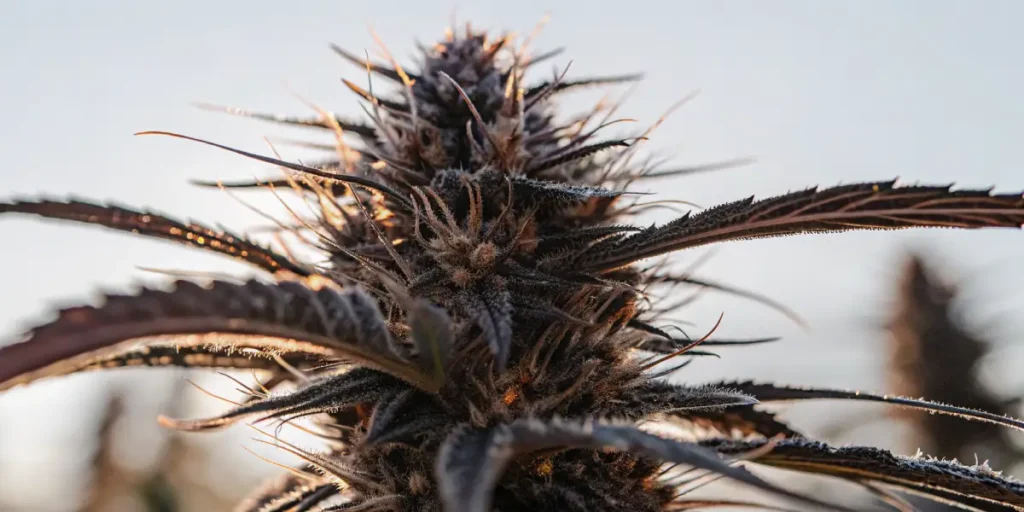
Practical Tips for Optimizing Laticifer Function
To boost laticifer function, start with selecting the right strain. Some, like Sour Diesel and Grape Ape, are naturally inclined to produce more resin. This gives you an inherent advantage in maximizing laticifer output.
Environmental control is another crucial factor. Ensure your grow space maintains stable temperatures and humidity levels. Fluctuations can stress the plant and impair laticifer function. Consistent conditions support healthy growth and resin production.
Lighting is a critical element in optimizing laticifer function. Understanding the importance of laticifers in cannabis helps growers see how providing the right spectrum and intensity can stimulate laticifer activity, ensuring robust resin development. Adjusting light cycles to mimic natural conditions can also enhance plant resilience and productivity.
Lastly, the strategic use of plant training techniques, such as topping and low-stress training, can improve laticifer efficiency. These methods encourage lateral growth, promoting more even distribution of nutrients and enhancing overall plant health, which is reflected in the quality of the resin produced.
FAQs
What are laticifers in cannabis?
Laticifers are specialized structures within the cannabis plant that produce and store latex. This sticky substance plays a crucial role in the plant’s health and defense. In cannabis, laticifers are especially important for resin production, which contains the plant’s valuable cannabinoids and terpenes.
The importance of laticifers in cannabis extends beyond just resin. They help seal wounds and deter pests, contributing to the plant’s overall resilience. For growers, knowing these structures can lead to better cultivation practices and higher-quality yields.
The function of laticifers in cannabis plant health is multifaceted, influencing not just the plant’s defense mechanisms but also its growth and development. By appreciating the complexity of these structures, cultivators can harness their potential to produce healthier, more productive plants.
Moreover, the impact of laticifers on cannabis resin production cannot be overlooked. These structures are integral to the plant’s ability to synthesize and store the compounds that define its psychoactive and therapeutic properties, making them indispensable to successful cannabis cultivation.
How do laticifers affect cannabis resin production?
Laticifers directly impact cannabis resin production by storing and transporting the compounds that make up the resin. These include THC, CBD, and various terpenes that give cannabis its unique properties. By optimizing laticifer function, growers can enhance both the quality and quantity of their resin.
Strains like OG Kush are known for their rich resin content, partly due to efficient laticifer activity. This makes them a popular choice for those looking to maximize the therapeutic and psychoactive effects of their cannabis.
The impact of laticifers on cannabis resin production is evident in the plant’s overall chemical profile. By facilitating the transport and storage of critical compounds, laticifers ensure that the cannabis plant produces resin with high concentrations of desirable cannabinoids and terpenes.
Additionally, knowing laticifer function in cannabis cultivation allows growers to implement strategies that enhance resin quality. Adjusting environmental factors and employing specific cultivation techniques can significantly influence laticifer efficiency, leading to improved resin properties and overall plant performance.
Can laticifers improve the plant’s defense mechanisms?
Yes, laticifers play a significant role in the plant’s defense mechanisms. They produce latex that acts as both a physical barrier and a chemical deterrent against pests and pathogens. This dual function helps protect the plant from damage and disease.
For growers, this means less reliance on chemical pesticides and healthier plants overall. By choosing strains with strong laticifer activity, such as Grape Ape, you can enjoy a more sustainable cultivation process.
The significance of laticifers in cannabis defense mechanisms is further underscored by their ability to activate systemic resistance within the plant. This broader defense strategy not only protects against immediate threats but also primes the plant for future challenges, enhancing long-term resilience.
Besides, laticifers enable the plant to respond swiftly to environmental stresses, sealing wounds and preventing pathogen entry almost instantaneously. This rapid response is crucial for maintaining plant health and ensuring continuous growth, particularly in unpredictable outdoor cultivation environments.
What is the significance of laticifers in cannabis therapeutic properties?
Laticifers contribute to cannabis’s therapeutic properties by aiding in the production of cannabinoids and terpenes. These compounds are responsible for the plant’s medicinal effects, such as pain relief and anxiety reduction. Properly functioning laticifers ensure a robust chemical profile, enhancing the plant’s therapeutic potential.
By focusing on laticifer health, growers can produce cannabis with enhanced medicinal qualities. Strains like Sour Diesel benefit from this, providing effective relief for various conditions.
The laticifers contribution to cannabis therapeutic properties is vital for meeting the diverse needs of medical cannabis patients. By optimizing these structures, cultivators can produce plants with specific cannabinoid and terpene profiles tailored to treat particular ailments.
Furthermore, knowing laticifer function in cannabis cultivation enables growers to enhance the plant’s medicinal value through precise environmental and nutritional management. This targeted approach ensures that the therapeutic compounds in cannabis are produced in optimal quantities and concentrations.
How can I optimize laticifer function in my cannabis plants?
To optimize laticifer function, start by selecting strains known for their high resin production, such as Sour Diesel and OG Kush. These strains naturally produce more resin, giving you a head start in maximizing laticifer output.
Environmental conditions are also crucial. Maintain stable temperatures and humidity levels to prevent plant stress. Adequate light and proper nutrition further support healthy laticifer development, leading to better resin quality and yield.
Incorporating advanced cultivation techniques, such as hydroponics or aeroponics, can also optimize laticifer function. These systems provide precise control over nutrient delivery and environmental conditions, promoting healthier plant development and increased resin production.
Additionally, regular monitoring and adjustment of growth parameters can lead to continuous improvements in laticifer activity. By staying attuned to your plants’ needs and making timely interventions, you can ensure that your cannabis plants consistently produce high-quality resin.













